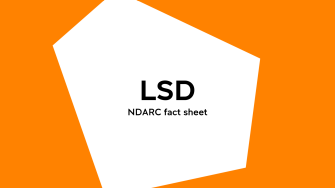2 Jun 2025
NDARC fact sheet:
LSD
LSD

Lysergic acid diethylamide (LSD) is a hallucinogenic drug that produces powerful sensory distortions, intensifies mood and alters thought processes.
LSD is usually prepared in liquid form, which is then dropped onto small pieces of blotting paper known as ‘tabs’.
It is usually taken orally, either through swallowing or sublingual (under the tongue) administration. In rare cases, LSD is inhaled, injected or applied to the skin.
The effects of LSD are usually experienced between 20 and 60 minutes after consumption. People typically report effects lasting for six to 11 hours, but this period can be longer depending on the dose.
The effects of LSD depend on the quantity consumed, the person’s height and weight, their general health, their mood, their past experience withLSD, whether they use LSD on its own or with other drugs, and the composition of the drug.
Short-term effects may include:
Long-term effects may include:
People who use LSD can sometimes experience a ‘bad trip’, involving a disturbing hallucination. This can lead to panic and risky behaviour.
Overdose, psychological dependence, and ‘flashbacks’ are also risks when using LSD.
Though rare, deaths due to LSD toxicity have been documented in Australia and elsewhere. Most deaths, however, are due to traumatic injury, such as from falls. Taking LSD can result in extremely distorted perception, unstable or depressed mood, or intense fear.
The effects of taking LSD with other drugs − including over-the-counter or prescription medications − can be unpredictable and dangerous. For instance:
LSD is not thought to cause physical dependence; however, some people may develop psychological dependence.
Hallucinogens have the potential to give rise to psychotic symptoms, sometimes known as a ‘bad trip’. It has been found that following a single dose, healthy volunteers can experience both positive and negative psychotic symptoms.
People who use LSD do not generally seek treatment from health professionals and there are few treatment options that can be recommended, apart from those found to be generally effective for drug dependence like motivational enhancement, cognitive behavioural therapy, contingency management, and social support services.
According to the Australian Institute of Health and Welfare’s National Drug Strategy Household Survey, use of hallucinogens is increasing. Between 2019 and 2022-2023, lifetime use of hallucinogens increased 10.4% to 12.2%, and recent use increased from 1.6% to 2.4%.
The Illicit Drug Reporting System (IDRS) is an Australian monitoring system run by the National Drug and Alcohol Research Centre (NDARC) at UNSW Sydney that identifies emerging trends of local and national concern in illicit drug markets.
The Ecstasy and Related Drugs Reporting System (EDRS) is an Australian monitoring system run by NDARC that identifies emerging trends of local and national interest in ecstasy and related drug use, markets and harms.
The Pocket Guide to Drugs and Health is a publication authored by experts from NDARC that provides information for health professionals on the impact of drug use.
The Australian Institute of Health and Welfare collects information on alcohol and tobacco consumption, and illicit drug use among the general population in Australia.
The Australian Bureau of Statistics is Australia’s national statistical agency, providing official statistics on a range of economic, social, population and environmental matters of importance to Australia.
Alcohol and Drug Foundation (2024). LSD. Retrieved from: adf.org.au/drug-facts/lsd/
Australian Institute of Health and Welfare (2024). Hallucinogens in the NDSHS. AIHW, Australian Government. Retrieved from: aihw.gov.au/reports/illicit-use-of-drugs/hallucinogens-ndshs
Darke, S., Lappin, J., & Farrell, M. (2024). The Clinician’s Guide to Illicit Drugs and Health (Revised Edition); London: Silverback Publishing.
Darke S, Duflou J, Peacock A, et al (2024). A retrospective study of the characteristics and toxicology of cases of lysergic acid diethylamide (LSD)- and psilocybin-related death in Australia. Addiction. Retrieved from: doi.org/10.1111/add.16518
Swift, W., Nielsen, S., Kaye S, et al (2017). A Quick Guide to Drugs & Alcohol. Third Edition. Drug Info, State Library of New South Wales.
If you, or someone around you, is experiencing undesired or distressing psychological or physical symptoms from the intake of alcohol or other drugs, please seek immediate medical attention.
If you need urgent help from ambulance services, call Triple Zero (000). If a person has been mixing drugs with alcohol or other drugs, tell the paramedic exactly what has been taken.
For free and confidential advice about alcohol and other drugs, call the National Alcohol and Other Drug Hotline on 1800 250 015. The hotline will automatically direct you to the Alcohol and Drug Information Service in your state or territory.
2 Jun 2025
Fact Sheets
NDARC
Download this resource